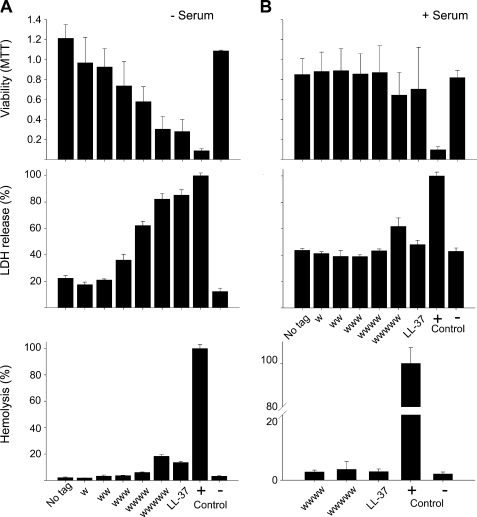FIGURE 2.
Activities of peptides against eukaryotic cells. A, effects of peptides on HaCaT cells and erythrocytes in absence of human serum. The MTT assay (top panel) was used to measure viability of HaCaT keratinocytes in the presence of GKH17 peptides with variable Trp tagging. In the assay, MTT is modified into a dye, blue formazan, by enzymes associated with metabolic activity. The absorbance of the dye was measured at 550 nm. The cell permeabilizing effects of the indicated peptides (middle panel) were measured by the LDH-based TOX-7 kit. Hemolytic effects (bottom panel) of the indicated GKH17 variant peptides were investigated, and the corresponding data for LL-37 are included for comparison. The cells were incubated with the peptides at 60 μm, and 2% Triton X-100 served as positive control. The absorbance of hemoglobin release was measured at 540 nm and is expressed as a percentage of Triton X-100-induced hemolysis (note scale of y axis). MTT, the difference between the WWW and longer variant peptides versus no tag is significant (p < 0.05, one-way ANOVA). LDH, the difference between the WWW and longer variant peptides versus no tag is significant (p < 0.05, one-way ANOVA). Hemolysis, the difference between the WWWWW variant versus no tag is significant (p < 0.05, one-way ANOVA). B, effects of GKH17 and Trp-modified variants in the presence of human serum. Identical experiments as in A were performed in presence of human 20% serum. For assessment of hemolysis in presence of serum, only those peptides displaying significant hemolytic activities in absence of serum were analyzed. MTT, there is no significant difference between the peptide variants. LDH, the difference between the WWWWW variant peptide versus no tag is significant (p < 0.05, one-way ANOVA). Hemolysis, there is no significant difference between the peptide variants.

